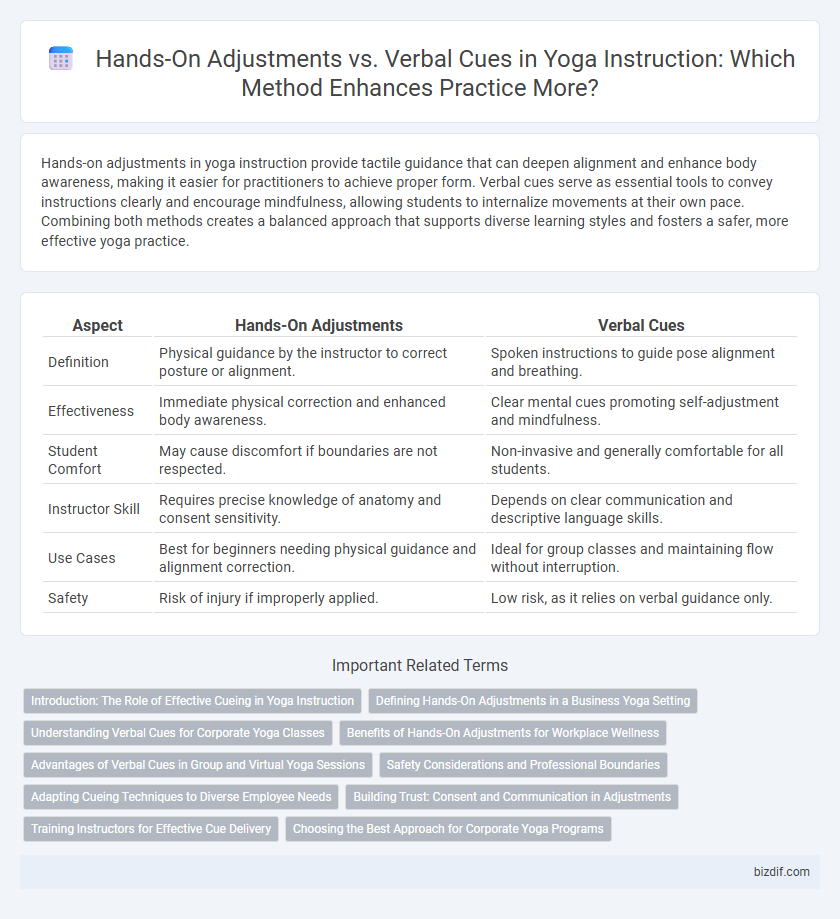Hands-on adjustments in yoga instruction provide tactile guidance that can deepen alignment and enhance body awareness, making it easier for practitioners to achieve proper form. Verbal cues serve as essential tools to convey instructions clearly and encourage mindfulness, allowing students to internalize movements at their own pace. Combining both methods creates a balanced approach that supports diverse learning styles and fosters a safer, more effective yoga practice.
Table of Comparison
| Aspect | Hands-On Adjustments | Verbal Cues |
|---|---|---|
| Definition | Physical guidance by the instructor to correct posture or alignment. | Spoken instructions to guide pose alignment and breathing. |
| Effectiveness | Immediate physical correction and enhanced body awareness. | Clear mental cues promoting self-adjustment and mindfulness. |
| Student Comfort | May cause discomfort if boundaries are not respected. | Non-invasive and generally comfortable for all students. |
| Instructor Skill | Requires precise knowledge of anatomy and consent sensitivity. | Depends on clear communication and descriptive language skills. |
| Use Cases | Best for beginners needing physical guidance and alignment correction. | Ideal for group classes and maintaining flow without interruption. |
| Safety | Risk of injury if improperly applied. | Low risk, as it relies on verbal guidance only. |
Introduction: The Role of Effective Cueing in Yoga Instruction
Effective cueing in yoga instruction enhances student alignment, safety, and deeper mind-body connection by providing clear guidance. Hands-on adjustments offer tactile feedback that can correct posture subtly, while verbal cues articulate precise instructions for breath, movement, and focus. Mastery in blending these methods fosters improved student engagement and personalized practice experiences.
Defining Hands-On Adjustments in a Business Yoga Setting
Hands-on adjustments in a business yoga setting involve the instructor physically guiding or modifying a participant's posture to enhance alignment, prevent injury, and deepen the practice. These tactile interventions require clear communication and consent to maintain comfort and professionalism, fostering trust and personalized support. Effective hands-on adjustments improve participant experience by addressing individual needs beyond what verbal cues alone can achieve.
Understanding Verbal Cues for Corporate Yoga Classes
Verbal cues in corporate yoga classes enhance alignment and mindfulness by providing clear, descriptive instructions tailored to diverse skill levels. Emphasizing tone, pace, and language ensures accessibility and fosters a non-intrusive, inclusive environment that respects personal boundaries. Mastering verbal communication reduces the need for hands-on adjustments while maintaining effective guidance in busy office wellness programs.
Benefits of Hands-On Adjustments for Workplace Wellness
Hands-on adjustments in yoga instruction enhance workplace wellness by providing personalized alignment corrections that reduce physical strain and improve posture. These tactile cues foster deeper body awareness and encourage mindful movement, which can alleviate stress and boost overall productivity. Integrating hands-on guidance supports employees' mental and physical health, leading to a more balanced and focused work environment.
Advantages of Verbal Cues in Group and Virtual Yoga Sessions
Verbal cues enhance clarity and accessibility in group and virtual yoga sessions by providing precise instructions that reach all participants simultaneously. They enable instructors to maintain a safe environment without physical contact, essential for remote or socially distanced classes. Clear verbal guidance also fosters independence, encouraging practitioners to develop self-awareness and proper alignment throughout their practice.
Safety Considerations and Professional Boundaries
Hands-on adjustments in yoga require clear communication and consent to ensure student safety and respect for personal boundaries. Verbal cues provide precise guidance while minimizing physical contact risks, making them essential for maintaining professional boundaries. Prioritizing informed consent and individual comfort enhances the instructional environment's safety and trustworthiness.
Adapting Cueing Techniques to Diverse Employee Needs
Hands-on adjustments provide personalized physical guidance that can deepen alignment and enhance body awareness for diverse employees in yoga instruction. Verbal cues accommodate varying learning preferences by offering clear, detailed instructions that employees can internalize at their own pace. Adapting cueing techniques to individual needs fosters an inclusive environment, improving engagement and promoting safer, more effective practice outcomes.
Building Trust: Consent and Communication in Adjustments
Hands-on adjustments in yoga require clear communication and explicit consent to build trust between instructor and student, ensuring a safe and supportive environment. Verbal cues complement physical guidance by providing clarity and respecting personal boundaries, enhancing the overall alignment and experience. Prioritizing consent and open dialogue fosters confidence, promotes relaxation, and deepens the student-instructor connection during practice.
Training Instructors for Effective Cue Delivery
Training yoga instructors to balance hands-on adjustments with verbal cues enhances class safety and student understanding. Emphasizing clear, precise language helps instructors communicate alignment and movement effectively, while developing sensitivity in physical adjustments respects individual boundaries. Mastering this combination fosters deeper student engagement and promotes injury prevention during practice.
Choosing the Best Approach for Corporate Yoga Programs
Hands-on adjustments in corporate yoga programs provide personalized alignment corrections, enhancing participant safety and deepening posture awareness, while verbal cues foster autonomy and mindfulness crucial for office environments. Effective instructors assess individual comfort levels and workplace culture to balance tactile guidance with clear, concise verbal instructions that respect personal boundaries. Prioritizing verbal cues supplemented by optional hands-on adjustments ensures inclusivity and maximizes engagement in diverse corporate settings.
Hands-On Adjustments vs Verbal Cues Infographic

 bizdif.com
bizdif.com